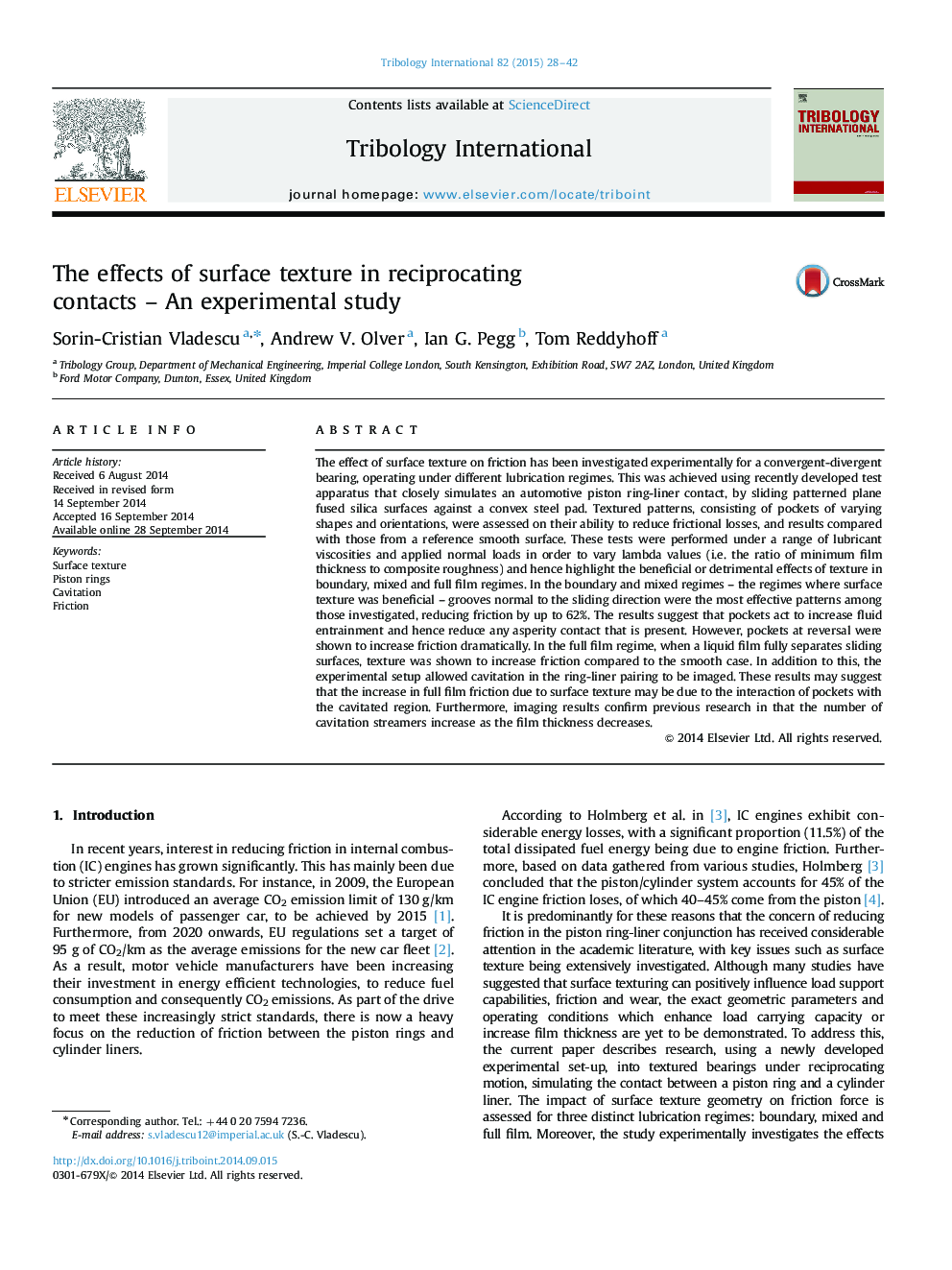| کد مقاله | کد نشریه | سال انتشار | مقاله انگلیسی | نسخه تمام متن |
|---|---|---|---|---|
| 614667 | 881409 | 2015 | 15 صفحه PDF | دانلود رایگان |
عنوان انگلیسی مقاله ISI
The effects of surface texture in reciprocating contacts - An experimental study
ترجمه فارسی عنوان
اثرات بافت سطحی در تماسهای متقابل - یک مطالعه تجربی
دانلود مقاله + سفارش ترجمه
دانلود مقاله ISI انگلیسی
رایگان برای ایرانیان
کلمات کلیدی
بافت سطح، حلقه های پیستون، کاویتاسیون، اصطکاک،
ترجمه چکیده
اثر بافت سطح بر اصطکاک به صورت آزمایشی برای یک تحمل یکنواخت-واگن که تحت رژیم های مختلف روانکاری عمل می کند، مورد بررسی قرار گرفته است. این با استفاده از دستگاه آزمایشگاهی که اخیرا توسعه یافته است، نزدیکترین شبیه ساز تماس یک حلقه لنت پیستونی خودرو، با کشیدن سطوح سیلیکای سیلیس با استفاده از الگوریتم پلاستیکی در برابر پد فولادی محدب است. الگوهای بافتی شامل جیب های مختلف شکل ها و جهت ها بر توانایی آنها برای کاهش تلفات اصطکاکی و نتایج در مقایسه با سطوح صاف مرجع مقایسه شد. این آزمایش ها تحت محدوده ویسکوزیته روانکاری و بارهای نرمال اعمال شده به منظور تغییر مقدار لامبدا (یعنی نسبت ضخامت ضخامت فیلم به زبری از کامپوزیت) انجام شده است و از این رو اثر آثار مفید یا زیانبار در رژیم های مرزی، مخلوط و فیلم کامل را برجسته می کند . در رژیم های مرزی و مخلوط - رژیم هایی که در آن سطح بافت مفید بود - شیارهای معمولی به جهت کششی، موثرترین الگوهای در میان آنها مورد بررسی بود، کاهش اصطکاک تا 62٪. نتایج نشان می دهد که جیب ها برای افزایش مایع مایع عمل می کنند و از این رو هر مخاطی که در آن قرار دارد، کاهش می یابد. با این حال، جابجایی در عقب باعث افزایش اصطکاک شد. در رژیم فیلم کامل، هنگامی که یک فیلم مایع به طور کامل سطوح لغزش را جدا می کند، بافت نشان می دهد که اصطکاک را نسبت به مورد صاف افزایش می دهد. علاوه بر این، راه اندازی تجربی حفره ای را در جفت شدن حلقه زنجیر به تصویر کشید. این نتایج ممکن است نشان دهند که افزایش اصطکاک فیلم کامل با توجه به بافت سطح ممکن است به دلیل تعامل جیب با منطقه حفره ای باشد. علاوه بر این، نتایج تصویربرداری تحقیق قبلی را تایید می کنند که در آن تعداد ضخامت فیلم ها کاهش می یابد.
موضوعات مرتبط
مهندسی و علوم پایه
مهندسی شیمی
شیمی کلوئیدی و سطحی
چکیده انگلیسی
The effect of surface texture on friction has been investigated experimentally for a convergent-divergent bearing, operating under different lubrication regimes. This was achieved using recently developed test apparatus that closely simulates an automotive piston ring-liner contact, by sliding patterned plane fused silica surfaces against a convex steel pad. Textured patterns, consisting of pockets of varying shapes and orientations, were assessed on their ability to reduce frictional losses, and results compared with those from a reference smooth surface. These tests were performed under a range of lubricant viscosities and applied normal loads in order to vary lambda values (i.e. the ratio of minimum film thickness to composite roughness) and hence highlight the beneficial or detrimental effects of texture in boundary, mixed and full film regimes. In the boundary and mixed regimes - the regimes where surface texture was beneficial - grooves normal to the sliding direction were the most effective patterns among those investigated, reducing friction by up to 62%. The results suggest that pockets act to increase fluid entrainment and hence reduce any asperity contact that is present. However, pockets at reversal were shown to increase friction dramatically. In the full film regime, when a liquid film fully separates sliding surfaces, texture was shown to increase friction compared to the smooth case. In addition to this, the experimental setup allowed cavitation in the ring-liner pairing to be imaged. These results may suggest that the increase in full film friction due to surface texture may be due to the interaction of pockets with the cavitated region. Furthermore, imaging results confirm previous research in that the number of cavitation streamers increase as the film thickness decreases.
ناشر
Database: Elsevier - ScienceDirect (ساینس دایرکت)
Journal: Tribology International - Volume 82, Part A, February 2015, Pages 28-42
Journal: Tribology International - Volume 82, Part A, February 2015, Pages 28-42
نویسندگان
Sorin-Cristian Vladescu, Andrew V. Olver, Ian G. Pegg, Tom Reddyhoff,
